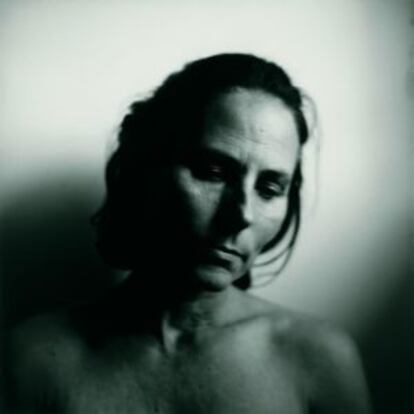Emmet Gowin’s inner universe
American photographer brings his intimate portraits and remarkable landscapes to the PHotoEspaña festival

The indecipherable, the almost inexplicable and the never-ending mystery of private life conforms the fascinating black-and-white universe of Emmet Gowin, one of the leading exponents of photography in the second half of the 20th century. Now, this poetic universe is on display at Madrid's Fundación Mapfre, in what is Spain's first exhibition of this living legend of photography.
He met his wife, Edith Morris, in the fall of 1960. Gowin was already interested in photography at the time, and felt fascinated by nature and life's cycles. But after meeting Edith, his camera seemed incapable of finding better subject matter. They were married in 1964, and for the next two decades, Edith and her world became the undisputed stars of Gowin's work. She is depicted from the front, from the back, in her night robe, in her best gown, nude, pregnant, alone, in the company of relatives...
A tall, attractive man with a voice reminiscent of the great actors of Hollywood's golden era, Emmet Gowin in person explained how one day, he decided to use his wife and relatives as the main subject for his compositions, as they already contained everything that he was interested in.
"I took most of these photographs during the Vietnam War years; the odd critic said back then that there was something incestuous about my work. But I was looking for something to offer people, and there was nothing better than shots of my family. Discovering how much I loved my wife was a reaffirmation of what was important in life, of what was truly precious to me. Thinking about their own families was also a reason why the soldiers would want to come back from the front."
My only intention is to discover reality; I do not send out any messages¨
The show, which is part of Madrid's annual PHotoEspaña festival, opens and ends with a very beautiful series on Edith, but in between there is a lot of other subject matter as well. In all, there are 180 black-and-white images, save for a series on Andalusian landscapes, which the photographer took expressly for his first Spanish exhibition.
The landscapes that had captured his interest as a teenager are showcased in a series of photographs taken at various moments in his life, during trips to Europe, Asia and the American Midwest. He focuses particularly on the strange beauty of the narrow, winding streets of Matera in southern Italy, and the rock-hewn homes of Petra, in Jordan.
But it was in his own country that he made some of his most widely acclaimed landscape series. Gowin, however, admits that he is not happy about being categorized as an environmental photographer. "My only intention is to discover reality; I do not send out any messages."
Yet his series on the Hanford Site, a nuclear arsenal in Washington State, and the barren territory near the Columbia River, constitute a decalogue of the various ways in which humans manage to destroy the landscape. His shots of irrigation circuits in Kansas and the moonscapes of Nevada are reminiscent of abstract expressionism, although Gowin insists that his photography contains no artifice. "I do not manipulate, but I am very much in favor of implementing new technologies. Thanks to a sophisticated scanning system, the Smithsonian has recovered images of Civil War soldiers that had completely disappeared. It is miraculous... and marvelous."
His aerial shots of Andalusia also border on the miraculous, Gowin explains: "I was told I had two days to take the shots. I thought this was impossible. But they came out in two minutes. As the Bible says, God gives eyes to those who want to see."
The end of the show focuses on the jungles of Latin America, with his wife (naturally) serving as a model along with hundreds of butterflies. So why are there no self-portraits, at least in his family series? "Because I am already present in my work," he replies. "In my pictures you will see me."
Tu suscripción se está usando en otro dispositivo
¿Quieres añadir otro usuario a tu suscripción?
Si continúas leyendo en este dispositivo, no se podrá leer en el otro.
FlechaTu suscripción se está usando en otro dispositivo y solo puedes acceder a EL PAÍS desde un dispositivo a la vez.
Si quieres compartir tu cuenta, cambia tu suscripción a la modalidad Premium, así podrás añadir otro usuario. Cada uno accederá con su propia cuenta de email, lo que os permitirá personalizar vuestra experiencia en EL PAÍS.
¿Tienes una suscripción de empresa? Accede aquí para contratar más cuentas.
En el caso de no saber quién está usando tu cuenta, te recomendamos cambiar tu contraseña aquí.
Si decides continuar compartiendo tu cuenta, este mensaje se mostrará en tu dispositivo y en el de la otra persona que está usando tu cuenta de forma indefinida, afectando a tu experiencia de lectura. Puedes consultar aquí los términos y condiciones de la suscripción digital.
Últimas noticias
The complicated life of Francesca Albanese: A rising figure in Italy but barred from every bank by Trump’s sanctions
How Japan is trying to avert ‘digital defeat’
Half of Scotland is in the hands of 420 property owners
Reinhard Genzel, Nobel laureate in physics: ‘One-minute videos will never give you the truth’
Most viewed
- Pablo Escobar’s hippos: A serious environmental problem, 40 years on
- Why we lost the habit of sleeping in two segments and how that changed our sense of time
- Charles Dubouloz, mountaineering star, retires at 36 with a farewell tour inspired by Walter Bonatti
- Reinhard Genzel, Nobel laureate in physics: ‘One-minute videos will never give you the truth’
- The Florida Keys tourist paradise is besieged by immigration agents: ‘We’ve never seen anything like this’








































